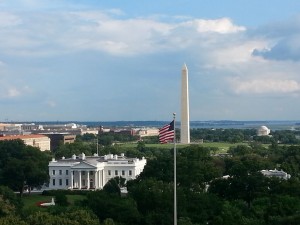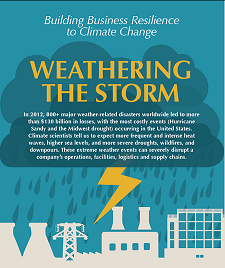
One major component of Bard College’s Center for Environmental Policy curriculum is an intensive four- to six-month internship designed not only to give students work experience in an area of interest, but also provide time to work on in-depth projects, network, and maybe find that aha moment leading to the development of a thesis.
Given my background in meteorology, interest in climatology, and desire to learn more about national and international climate policy, it is fitting that I ended up at the Center for Climate and Energy Solutions (C2ES), an independent, non-profit, non-partisan organization in Arlington, Va., consistently ranked among the top environmental think tanks in the world.
What does C2ES do?
The mission of C2ES is “to advance strong policy and action to address our energy and climate challenges.” C2ES believes that by bringing diverse stakeholders together to craft innovative policy, it can spur development of safe, efficient energy and keep the challenges of a changing climate from becoming a true crisis.
C2ES tackles this challenge in four ways, by:
-

Image: Weathering the Storm. A report compiled as part of the Business Resilience program. Providing scientific, economic and policy analyses to supply timely and impartial information on the causes and consequences of climate change, our critical energy choices, and ways to make a difference.
-
Bringing together city, state, national and international policymakers, business leaders, environmental experts, academics and other stakeholders to achieve common understandings and consensus solutions.
-
Facilitating concrete action through interactions with members of its Business Environmental Leadership Council and through programs such as Make an Impact, which helps employees and consumers save energy and money and reduce their carbon footprints.
-
Developing and promoting resources to help both experts and citizens understand the issues, track government efforts, and contribute to the policy process.
What do I do?
As the Science and Resilience Intern, I assist on projects assigned to the Markets and Business Strategies and Science and Impacts teams. These teams work together to incorporate climate change information into economic, social, and environmental assessment reports. The synthesis of scientific and economic data allows business and government decision-makers to identify policy options for resilience ventures. Over the past six weeks, I have been involved in a number of projects. These include:
- Updating the C2ES Extreme Weather page. This is one of the most visited pages on the organization’s website and identifies billion-dollar extreme weather events since 2000.
-
Writing a blog that summarizes and responds to a recent paper by a team of researchers at the National Oceanic and Atmospheric Administration (NOAA) and National Centers for Environmental Information (NCEI) who identify biases in land and ocean temperature data. Through reanalysis of the data, they concluded there has been no hiatus, or slowdown, in the rate of global warming.
-
Researching the climate action plans and emissions reduction goals of Vermont and Massachusetts to assess whether reductions have been a result of policy or past market mechanisms.
-
Assisting with updating the Cost of Inaction section of the 2015 update of Maryland’s Climate Action Plan. Some of the data for this project comes from the American Climate Prospectus as part of an analysis undertaken by Risky Business.
-
Sitting in on Business Environmental Leadership Council and Resilience Workshop meetings, organized and facilitated by C2ES. These meetings bring together a broad range of companies, utilities, government officials and NGOs to discuss the economic and environmental impacts of climate change and the challenges facing stakeholders in mitigating and adapting to these impacts.
What skills have I used?
During my first few weeks at C2ES, I have already used many of the skills developed during my first year at Bard CEP. I have used my knowledge in econometrics and statistics to better understand how modeled climate data can be married with current economic data to provide detailed projections of costs to local economies, complete with likely ranges and probability distributions.
In comparing states’ climate and energy use plans, I have used my skills in writing literature reviews and policy memos, and in breaking down detailed and technical information in a manner that is useful for a different audience. I have even referred back to papers I read in various climate science classes to include in my reports about how climate change will impact health, water, and agriculture.
Most importantly, though, these first-year skills have provided me with a solid foundation to learn even more. There is a whirlwind of activity right now within various levels of government, the business community, and energy sector to combat climate change and increase resilience. Sitting in on stakeholder meetings, interacting with policy experts, and observing presentations by co-workers have all been profound educational experiences.
My time thus far at C2ES has been immensely rewarding, and I feel as though I have made meaningful contributions to projects undertaken by the organization. I am looking forward to my remaining time here and working with such a dedicated group of individuals.

